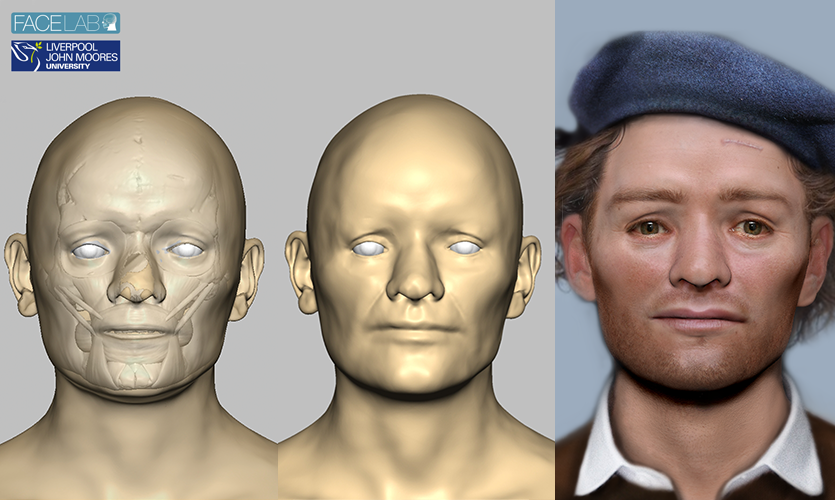LJMU reveals digital image bringing people face to face with Seventeenth Century Scottish soldier
The soldier had been imprisoned and died in Durham following the Battle of Dunbar in 1650, but now his image has been revealed through a remarkable new digital reconstruction.
Face Lab specialises in the reconstruction of faces for archaeological and forensic purposes and worked with archaeologists at Durham University to reconstruct a ‘true to life’ 3D image of the solider after his remains were uncovered in Durham in 2013.
The reconstruction is based on the skull of a male, known only to the project team as ‘Skeleton 22’.
Analysis of Skeleton 22, led by experts at Durham University, showed that he was aged between 18 and 25 when he died, had suffered periods of poor nutrition during childhood and had lived in South West Scotland during the 1630s.
The images and video, were created by careful re-assembly the skull to allow for a detailed digital scan to be undertaken.
This scan was used with the research from Durham University to build up facial features, including a previously unidentified facial scar.
Professor Caroline Wilkinson, of Face Lab, said: “This unique facial image was created using the very latest techniques housed at Liverpool John Moores University’s Face Lab.
“This combines a 3D craniofacial depiction system with digital modelling software and facial and anatomical datasets, which can provide the most accurate and lifelike images of an array of fascinating archaeological and forensic art depictions.
“In this case, our collaboration with Durham University enabled us to draw on scans and data to create the most accurate and lifelike image possible to enable a true glimpse into the past of this Scottish soldier and how his life had been lived.”
She added: “It will join a collection of work by Face Lab reconstructing historical figures including Robert the Bruce, Richard III and St Nicholas.”
The soldier is depicted wearing the blue bonnet, brown jacket and shirt typical of Scottish soldiers of the time.
Durham University Department of Archaeology Professor Chris Gerrard said: “Analysis of the dental calculus has revealed a lot about the conditions in which this man, known to us only as ‘Skeleton 22’, grew up.
“This information combined with the digital facial reconstruction gives us a remarkable, and privileged, glimpse into this individual’s past.”
The Battle of Dunbar was one of the most brutal and short battles of the Seventeenth Century civil wars, after which thousands of soldiers were marched over 100 miles from the South East of Scotland to Durham in North East England. Around 3,000 soldiers were imprisoned in Durham Cathedral and Castle, at a time when the Cathedral was empty and abandoned.
Soldiers who survived imprisonment in Durham were employed locally in coal mines, at salt pans and as weavers whilst others were sent to King’s Lynn to help with drainage projects on the Fens. But some were also sent to France to fight or crossed the Atlantic to places such as Barbados and New England, USA, where they worked as indentured servants.
Once research on the remains is completed they will be reburied at the Elvet Hill Road Cemetery in Durham City, close to where the remains were originally found.
In 2018 Durham University will host an exhibition about the Scottish Soldiers and the archaeological research that has helped uncover their story. The exhibition entitled Bodies of Evidence: How Science Unearthed Durham’s Dark Secret will be held at the University’s Palace Green Library, which is part of the complex of buildings where the remains were found in 2013.
For further information please visit: www.durham.ac.uk/scottishsoldiers




